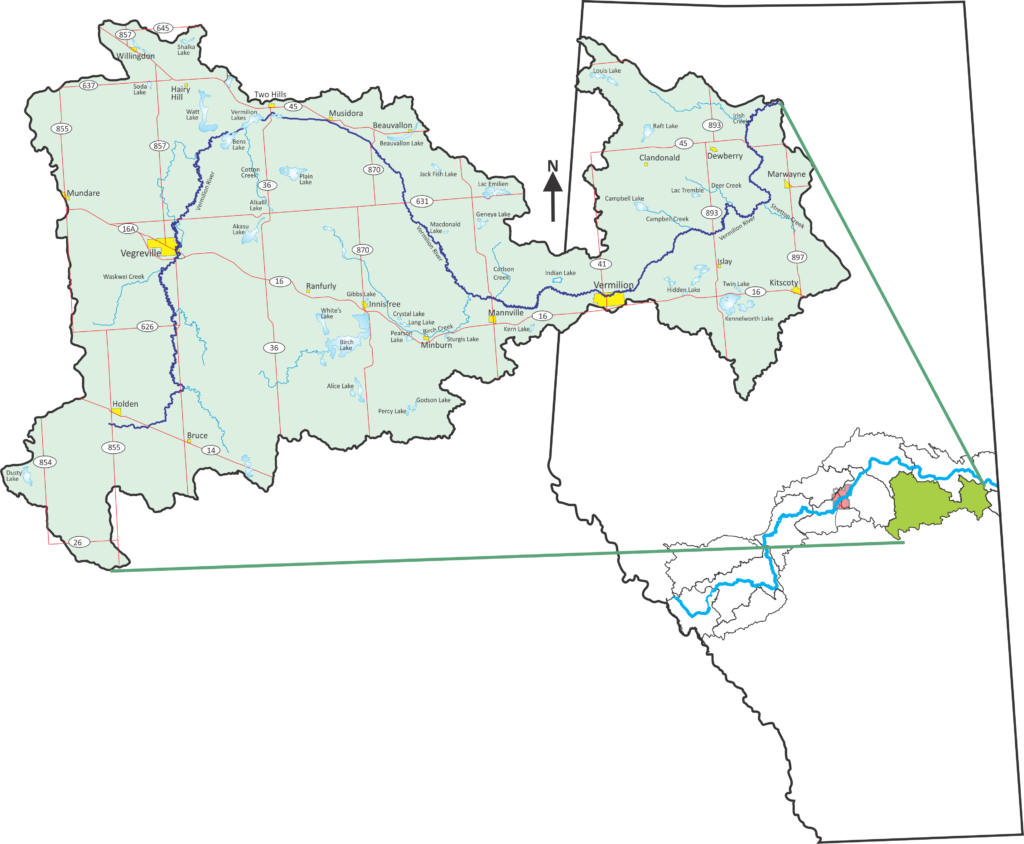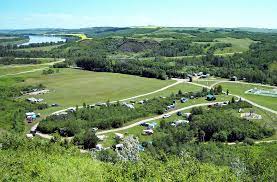Introduced and Edited by Robert W Hendriks 2024
Almost 12,000 years ago, the last of the massive glaciers in Alberta melted as they retreated northward creating vast amounts of water which began seeking lower levels, following the many channels that had been cut into the landscape by the glaciers. Each quickly filled up with huge amounts of meltwater flowing rapidly eastward out of the Rocky Mountains, across the parklands and the prairies creating a large number of rivers. Over time one of them important in this story, became known as the North Saskatchewan, travelling over 750 km before entering what is now known as Saskatchewan.

About the same time, a tributary Coming to life about 300 km west began emptying into the North Saskatchewan at a point about 16 km north of present day Marwayne, Alberta. It was following a glacial channel which narrowed and became deeper. Millions of gallons of glacial water loaded with sediment and debris spewed out onto the flood planes. Because of reddish clay at certain levels on the banks this river was named the Vermilion River. Over the next few thousand years, the flow diminished to a narrow stream bubbling over rocks, flowing peacefully through an area surrounded by steep banks, some heavily eroded. Willows and aspen line the banks. Grassy meadows could be seen all around. It was a beautiful place, very park like.
In fact, it was so pleasant that it became a gathering place for indigenous peoples primarily Cree and Blackfoot. Fur traders realized that this would be a good place to trade so about 1802 two trading posts were set up on higher ground must across from the mouth of the Vermilion river., one by Hudson Bay company ( Paint Creek House) and the second post by the Northwest Company (Fort Vermilion). Trading eventually dropped off and the posts were closed. However, a lovely place like this was chosen by early settlers moving into this territory about 100 years later and it became busy again.

Today we call it Lea Park. But how did it get that name?
Following is information gathered by Gerald West*, long established rancher living close by who owned a portion of this property. His story should be regarded as a true account of the founding of this gem in East Central Alberta.
“ This information was given to me by Fred Cox, who came to Canada from England in 1902. A stonemason and bricklayer by trade he worked in Winnipeg then in Lloydminster before settling on NW-2-54- W4th where he farmed for 50 years. He was at the meeting when Lea Park was named.
As the area became more settled the need for a post office was discussed. A meeting was held at the home of Martha and Hugh Graham to apply for a post office. It had to have a name and location, Mr. Cox was present at the meeting, Some of the settlers came from Scotland and England where it was the custom to refer to their low spots and meadows as Lea. and since this area also had many meadows and low spots, those at the meeting decided to name it as it would’ve been in England and Scotland, and that was LEA. The word PARK was added. Hence the name Lea Park was chosen on 16 November 1908. Mr. Graham was give approval by the federal government post office division to be located at their home on SE-4-54 W4. In 1910 the Grahams relocated to the Heinsburg area and no longer served as postmasters.
At that time Charles Pickles had a store on the south side of the North Saskatchewan River at the first bridge across the Vermilion river which was located on the modern 897 highway. On July 15, 1910 a second Lea Park post office was relocated there.
In 1914 Mr and Mrs. Alfred Hovey bought Pickles store and moved it about a half mile closer to the rive, In 1922 they sold it to Ed Klinkner. Edward Robert Pawsey bought the store and post office in 1947 and it ran until 1954. It was then rented to L.W. Witzany for a short time but closed in January 1955.
In it’s early days Lea Park had a ski hill, stampede and ball games. In modern times accessibility was greatly improved by the construction of a bridge across the North Saskatchewan in 1957. Lea Park has a scenic regional park complete with camping areas, some with services and a lovely nine hole golf course partly bordered by the Vermilion River. And the annual professional Lea Park Rodeo entertains very large crowds for several days.”
In closing, Gerald West has this to offer: “Lea Park forever - where the two rivers meet”


